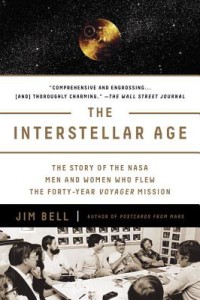 Last year, I started to get on a little bit of a kick for books about space and space travel. It started with Chris Hadfield’s really wonderful memoir An Astronauts Guide to Life on Earth and continued with Leaving Orbit by Margaret Lazarus Dean. And then of course there was The Martian (audio book and movie), and following Commander Scott Kelly on Instagram during his year in space aboard the International Space Station.
Last year, I started to get on a little bit of a kick for books about space and space travel. It started with Chris Hadfield’s really wonderful memoir An Astronauts Guide to Life on Earth and continued with Leaving Orbit by Margaret Lazarus Dean. And then of course there was The Martian (audio book and movie), and following Commander Scott Kelly on Instagram during his year in space aboard the International Space Station.
All that to say I was pretty excited to get a review copy of The Interstellar Age: The Story of the NASA Men and Women Who Flew the Forty-Year Voyager Mission by Jim Bell, an account of the men and women who manned the two Voyager missions that launched from Earth in 1977. Over the last 40 years, the spacecraft have provided some of the most iconic photographs of our solar system, collected and transmitted data about little-known planets, and made the journey out of the Solar System and into interstellar space.
It’s truly incredible to think that these machines have been operating successfully for that long, that we have the capability to transmit information from distance parts of the galaxy, and that these machines could be intercepted by other intelligent beings as they continue their journey into the unknown. Bell, a professor in the School of Earth and Space Exploration at Arizona State University and president of the Planetary Society, clearly approaches the subject with affection and enthusiasm, which I appreciated.
Unfortunately, The Interstellar Age was a little too heavy on the science for my taste, and didn’t dig deep enough into the personal stories of the scientists who participated in the Voyager missions for me to fully get into the story. Bell did interviews with many of the scientists involved with Voyager over the years, but their stories did a lot of telling, not showing, and didn’t give the necessary narrative flair to make up for the more difficult science passages. It’s hard to get some of that drama as part of a retrospective, but I wish there was a little more push to get a sense of what it felt like to be in the room during the major parts of each mission.
Despite my interest in space, The Interstellar Age didn’t quite find the balance between science and story that I look for in my nonfiction, but I know other readers with more patience for astrophysics will find a lot to enjoy in this book.

Comments on this entry are closed.
I’m wondering how Scott Kelly is going to readjust to gravity. This would probably be too heavy on science for me too.
I’m going to miss his Instagram pictures from space so much. But I’m super curious to hear about what they learn about long-term time in space from his participation.
I had added this to my Amazon wishlist a short while ago, possibly because I saw you post something about it and that brought it to my attention. Can’t wait to read it.
I hope you love it!
Hahahaha, you know, I always think that I want nonfiction books to contain MOAR SCIENCE, and I forget that I do not ultimately know enough about science to want/be able to follow dense science sections in books. And it’s soooo important, in nonfiction like this, to find a balance between contextual info and personal stories. I just finished reading Jamie Bartlett’s The Dark Net (excellent!), and it hit this balance just right.
Yeah, I think I’m the same way. I want to read lots of science, but really only have a certain tolerance/understanding for it and then I start to skim. The Dark Net sounds so good!
Sounds like a good one, though I confess I’d skim the science part.
“A Man on the Moon” by Andrew Chaikin is one of my favorite books from the space reading spree I dove into a few years ago. A more human-focused approach, which suits me as a reader.
Thanks for the recommendation, I’ll have to look for that one!
This sounds like a fascinating topic, but I’m not sure if the balance would be any better for me than for you. Since it’s outside my field, I expect I’d have less patience for science than I might in something I was more familiar with and I do prefer nonfiction to include a decent amount of personal stories.
Given the subtitle of the book — “The story of the NASA men and women who flew the forty-year Voyager mission — I was really hoping there’d be more personal stories. It’s clear there were a lot of interviews, but I didn’t feel like the anecdotes that were shared really got to the heart of what it meant to be part of this project (or where the conflicts arose among participants).